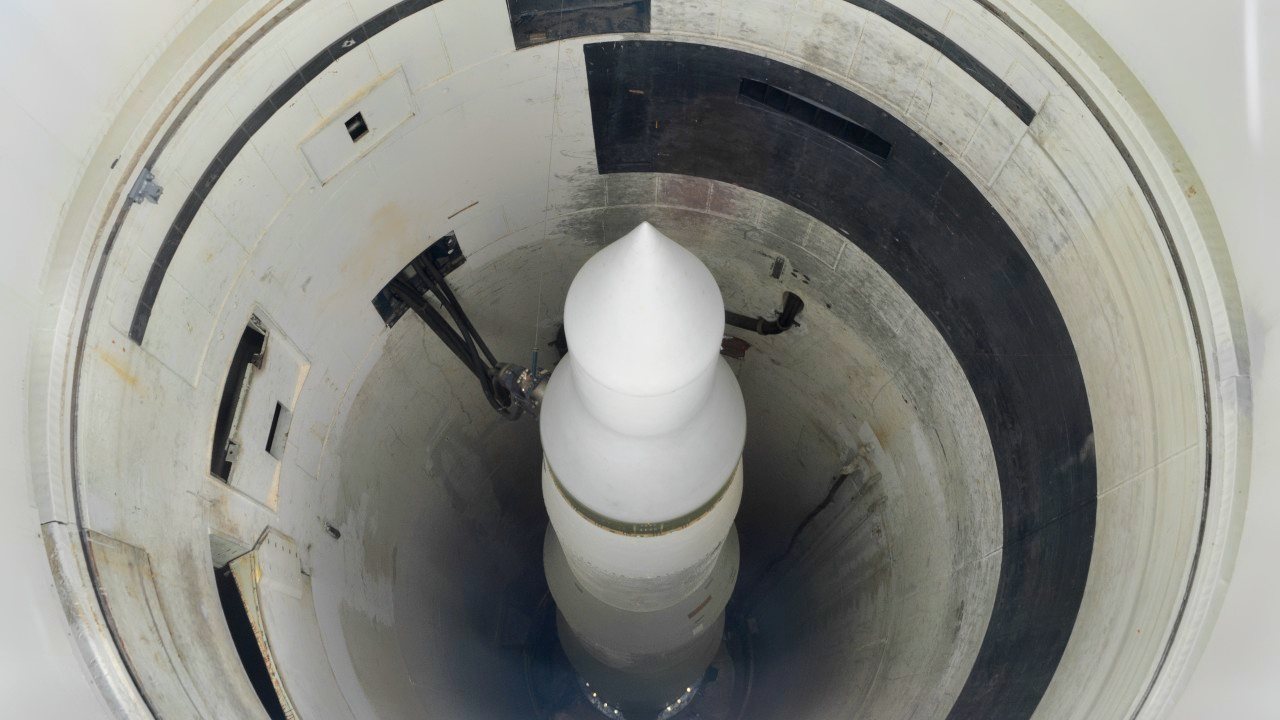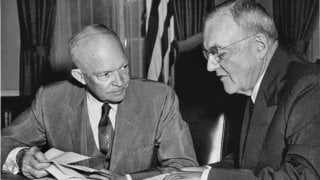How Eisenhower Reshaped the Joint Chiefs and U.S. Military Strategy
When Dwight D. Eisenhower became president, he aimed to overhaul the Pentagon and balance America’s defense spending with economic sustainability, an approach he called the “Great Equation.” To execute his vision, Eisenhower revamped the Joint Chiefs of Staff, appointing new leaders he believed would back his strategic shift toward nuclear deterrence and reduce reliance on conventional forces.
“They Have A Boss” - Ike’s Management of the Joint Chiefs - “I know better than any of you fellows about waste in the Pentagon and about how much fat there is to be cut because I've seen those boys operate for a long time.” When Dwight Eisenhower became president, he came with an agenda to massively reorganize and reform what he considered to be a vastly bloated federal bureaucracy, especially in the Department of Defense, and to drive through an entirely new national security strategy. But to accomplish his goals, he knew that he would need allies amongst both civilian appointees and the uniformed leadership in that vast organization.
Regarding the civilian leadership, the change of government allowed Eisenhower to usher out the by now nearly professional (the Roosevelt and Truman administrators combined for twenty years of political rule) political administrators who had headed up the multitude of three-letter-agencies that had emerged under the New Deal and replace them with businessmen who had experience running large organizations. As for the military, perhaps due to his familiarity with the current generation of military service leaders, Eisenhower wanted to install a new slate of uniformed heads of the military services, who also comprised the Joint Chiefs, to dramatically alter the nation’s military strategy.
The Great Equation
“Ike” arrived in the White House with a political and economic goals of restoring a healthy balance between the nation’s security requirements and its economic needs. During the 1952 presidential campaign he had referred to it as “the Great Equation.” Having observed the massive amounts of deficit spending needed to fund the Korean Conflict (which was still raging when he came into office), he had made it clear during his party platform that he planned to address both the nation’s rising inflation and the communist menace. The former soldier, to the degree that anyone could be a “former” five-star general, feared that runaway defense spending during World War II and the Korean conflict had placed the nation under the burden of a “Cross of Iron.’ When he assumed office the entire federal budget amounted to $76B with some 70% of those outlays going to the Department of Defense.
Eisenhower wanted to cut defense outlays by almost a third, but to do that he needed to shift the focus of the American military to high-tech nuclear weapons, which were largely lodged within the Air Force, as a deterrent force while tasking America’s allies in Europe and Asia to provide more conventional (ground) forces in their regions. This would allow him to cut the US Army and Marine Corps. The Navy was also in for some cuts to its battle force, but nowhere near the steep declines envisioned for the land and amphibious forces. To accomplish this, Eisenhower, a former Army Chief of Staff, knew that he needed support from inside the Pentagon, and he knew that “those boys” in the “five-sided-puzzle-palace” would resist his efforts to “cut the fat.”
In November 1952, shortly after his election, he began to discuss his plan to impose change upon the Department of Defense within his inner circle and even amongst conservative congressional leaders. He wanted new leaders, hand-picked allies, in the relatively new Joint Chiefs of Staff organization, which had emerged, along with the new “National Military Establishment” out of the National Security Act of 1947.
Dismissing the Joint Chiefs
The President-Elect knew that the term of the current Chairman of the Joint Chiefs, his old friend and West Point classmate, General of the Army Omar Bradley, was due to expire in the summer of 1953. Additionally, Army Chief of Staff, General J. Lawton Collins, was approaching the end of his second, two-year term. Eisenhower could have reappointed Collins, the general had not reached mandatory retirement age yet, but Ike decided not to. No one in the Army questioned the new president on this decision. Afterall, he was the victor of North Africa, Normandy, and Europe. The Army wouldn’t begrudge him a new Chief of Staff.
The Air Force Chief of Staff, General Hoyt Vandenberg represented another type of challenge. Vandenberg was one of the Air Force’s “boy generals” having entered World War II as a major and emerged from the conflict, which killed such a disproportionate number of airmen, as a three-star lieutenant general. Vandenberg had been appointed as the uniformed head of the air service in 1948 and should have either retired or accepted orders to another assignment in 1952, but Truman extended him as the Air Force Chief of Staff for another two-year term, for a potential total of six years in that newly created office, just to reach 30 years of service and full retirement benefits. “Ike” let “Van” know quickly that, having achieved his thirty years of service in the summer of 1953, it was time to move on. So, going into office, Eisenhower understood that he already was more than halfway towards a complete turnover of “the Chiefs.”
This was an era long before the Space Force, and the Commandant of the Marine Corps and the Chief of the National Guard Bureau did not have seats on the Joint Chiefs in 1953. Additionally, the role of a Vice Chairman of the Joint Chiefs would not come into existence until the Goldwater-Nichols Act of 1986. So, in early 1953 the Joint Chiefs were comprised of their Chairman, and the uniformed heads of the Army, Navy and Air Force. Thus, it was that the head of the Navy, the Chief of Naval Operations (CNO), then Admiral William Fechteler, was the only member of the team who reasonably expected to serve well into Eisenhower’s first term.
History and events had been hard on the CNO’s office in the years leading up to 1953. After nearly four years of wartime leadership under Fleet Admiral Earnest King, the office of CNO had been headed successively by three men who served two years or less. War hero Chester Nimitz had been made CNO as a reward for his leadership in the Pacific war, but was eager to retire after 42 years of service. Admiral Louis Denfield, Nimitz’s successor, was fired by the Secretary of the Navy after only a year and ten months for his role in “The Revolt of the Admirals” fight between the Air Force and the Navy over long range bombers and aircraft carriers. Denfield’s replacement, Admiral Forrest Sherman, served as the Navy’s leader for only a year and nine months before dying suddenly of a heart attack while touring naval installations in Europe. Fechteler, an uninspiring administrator by all accounts, was the Navy’s hope for stability, but Eisenhower didn’t care.
Charlie Wilson Recommends a New JCS
Shortly after assuming office, the new president acted. Given that the Army had held the Chairmanship first, the thought was that the Navy would be up next. In fact, there was some expectation that Fechteler would ascend to the head of the table. However, Charles Wilson, the CEO of General Motors, the world’s largest corporation and Ike’s pick to become Secretary of Defense, had developed a rapport with Admiral Arthur Radford, the Commander in Chief of the Pacific Command, during he and Eisenhower’s trip to visit the Korea in November 1952. Eisenhower, who was aware that Radford had been close to Douglas MacArthur, had some concerns, but provisionally gave Wilson some leeway.
Wilson also provisionally recommended elevating the Air Force Vice Chief of Staff, General Nathan Twining, as Vandenberg’s replacement. The president supported this. Like his recommendation for the Air Force’s top job, Wilson advocated for the Army’s Vice Chief of Staff, General John Hull, to be promoted to the top position, but here Eisenhower thought he knew better. Eisenhower picked General Matthew Ridgeway, who had replaced MacArthur in Korea in 1951 and Eisenhower himself at NATO in 1952. Ike respected Ridgeway immensely and thought that “Matt” would understand and support him in his reforms. Finally, the new administration approached Fechteler, who really couldn’t believe he was being moved out of his job. Facing a choice of retirement or a “promotion” to the senior Navy position in Europe, Fechteler signaled that he would take the assignment to the continent swapping places with Admiral Robert “Mick” Carney who was provisionally announced as the next Chief of Naval Operations.

Asking the Policy Question
The ”provisional” context is important. The new civilian secretaries for the Army, Navy and Air Force were told to order the new nominees to Washington, DC ahead of their confirmation hearings. Eisenhower wanted to confer with the nominees to ensure that they would be supportive of his “Great Equation” and, hence, his defense reforms and accompanying cuts. Twining, who was already naturally supportive of the direction Eisenhower wanted to go, was confirmed in his role in June of 1953. Radford arrived from Honolulu in July and began to backbench Bradley in meetings of the National Security Council to get a sense of where Eisenhower was going strategically. He picked up the importance of balancing the domestic economy with national defense needs quickly and backed Eisenhower.


